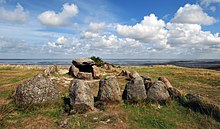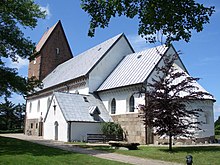Keitum
Keitum ( Danish : Kejtum , North Frisian : Kairem ) is a district of the municipality of Sylt on the island of Sylt in the district of North Friesland . The district has an area of 10.43 km².
The place is today due to its numerous avenues and the old trees as the green place of the island. Keitum is also known for its many, partly very old Frisian houses, which are often surrounded by stone walls ( Frisian walls ).
Harhoog megalithic tomb

The megalithic grave Harhoog in Keitum is a rectangular barrow , oriented in an east-west direction, with an "extended dolmen " or rectangular dolmen with a half-height entry stone as access . It consists of a burial chamber with a rectangular border, a so-called long bed , and was probably built around 3000 BC. . BC in the Chalcolithic period by members of the Funnel Beaker Culture established.
It is close to the swimming pool on the edge of the mudflats , but it is no longer at its original location. It was originally located in the hill called "Weenk" east of the wood between Keitum and Tinnum . It was exposed for the first time during the exploitation of a large sand pit for the construction of the Hindenburg dam in 1925 and after further sand extraction for the construction of the Nossekoog dike in 1936 it was scientifically examined. The stone chamber of the giant bed had to be relocated in June 1954 because the area for the expansion of Sylt airport was being demolished.
history
The place was first mentioned in a document in 1216. Until the middle of the 19th century, Keitum was the main town on the island of Sylt. The only doctor on the island practiced here and there was the only pharmacy, it was also the administrative seat for the lands on Sylt that did not belong to the Danish crown, and until December 31, 2008, the seat of the Sylt Landscape Office was located there . In the 17th and 18th centuries, numerous wealthy captains settled in Keitum, so that the place was the only one on the otherwise poor island to show a certain prosperity. One example of this is the Mühlenhof Keitum . Only with the onset of tourism did the importance of the seaside resort of Westerland grow . With the construction of the Hindenburg dam , Keitum was connected to the Reichsbahn network through its train station in the southwest of the town.

Uwe Jens Lornsen , pioneer of a united Schleswig-Holstein independent from Denmark, was born in Keitum on November 18, 1793. On March 24, 1896, the community put a memorial stone to “the greatest son of the island of Sylt”, which depicts Lornsen in a relief medallion modeled by the sculptor Wilhelm Wandschneider . The author Boy Lornsen , author u. a. of the children's book Robbi, Tobbi and the Fliewatüüt and the former director of the Staatliche Schauspielbühnen Berlin , Boleslaw Barlog , lived in Keitum. The visual artist Ingo Kühl has had a studio in Keitum since 2002 .
Keitum existed as an independent municipality until the Sylt-Ost municipality was formed in 1970. Munkmarsch was a district of Keitum. Smaller districts were Kaamp (east of Keitum) and Jückersmarsch and Klentertal (north of Keitum on the road to Munkmarsch).
Museums
The Sylt Heimatmuseum , a historic former captain's house, located directly on the Keitumer Kliff, shows the history of the island of Sylt, which was shaped by seafaring. In particular, whaling in the 17th and 18th centuries , which brought prosperity to the residents, is exhibited here. In addition to dishes, glasses, brass and silver items from that time, you can also visit Sylt traditional costumes. The museum dedicates its own section to Uwe Jens Lornsen, his life and work. The poets Johann Erichsen and Jens Emil Mungard , as well as the works of various painters, including Magnus Weidemann , Carl Arp , Max Koch , Fritz Overbeck and Carl Ludwig Jessen are presented. The modeled Kampener "Ziegenstall" (a bizarre Sylt cabaret bar) by Valeska Gert illuminates the Sylt nightlife after the Second World War .
The Old Frisian House , the house of the island chronicler Christian Peter Hansen , who died in 1879 , is now a museum. It gives an insight into the living culture of a captain's family in the 18th and 19th centuries .
church

→ Main article: Church of St. Severin
The St. Severin Church was built around 1216 and was originally dedicated to Saints Knut and Ketel. There are many field stones built into it and in the middle of the west wall there are two mirror images of natural stones, which, according to legend, were donated by the nuns Ing and Dung and also represent their image.
graveyard
In addition to old Sylt families, including well-known captain's families, several well-known personalities have found their final resting place in the cemetery of St. Severin Church. In addition to Rudolf Augstein , the former Federal Minister of the Interior Gerhard Schröder , the stage and film actor Uwe Dallmeier and the voice actor Edgar Ott , the publisher Peter Suhrkamp and the expressionist Ernst Mollenhauer are also buried there. The actor Ernst Otto Fuhrmann and the antique dealer Eduard Brinkama also found their final resting place there.
Others
On the northwestern outskirts of Keitum, the Balthasar Ress winery from Hattenheim in the Rheingau established Germany's northernmost vineyard on an area of one hectare in June 2009 . Protected from the wind on three sides by vegetation and favored by the high number of hours of sunshine on Sylt (1714 hours compared to 1587 hours in the Rheingau), a sufficient harvest quality can be expected from the early ripening varieties Solaris and Rivaner .
The Green Cliff extends southeast of Keitum on the coast of the Wadden Sea .
At Tipkenhoog there is one of the increasingly rare owner-run bookshops in Germany: the Keitum book chest .
Web links
Individual evidence
- ↑ Description of the vineyards on the Balthasar Ress winery homepage.
- ↑ Anna von Münchhausen and Pia Frey: Who opens everything with her. Stars, poets, politicians: they all come to the bookstore in Keitum. Then Hildegard Schwarz turns their heads. www.zeit.de, July 18, 2016, accessed on April 12, 2017 : “The Dichter-Sylt is conserved and cared for in a place that, according to all the rules of the market, should no longer exist: in the Keitum book chest from Hildegard Schwarz. "
Coordinates: 54 ° 53 ′ 36 ″ N , 8 ° 22 ′ 15 ″ E



